The Enthralling World of Rope Lights
Unraveling the Definition of Rope Lights
Rope lights, also known as tube lights, are a captivating and versatile form of lighting that has gained significant popularity in the recent past. They are essentially long, flexible tubes that encapsulate a series of miniature light bulbs or light-emitting diodes.
These tubes are fashioned from a translucent material, which allows the light to shine through while also protecting the light source from environmental factors. The charm of rope lights lies in their flexibility and adaptability.
They can be bent into many shapes and configurations without compromising their functionality, making them ideal for decorative or aesthetic use. Moreover, due to their long-lasting nature and low energy consumption – particularly in the case of LED rope lights – they are also suited for more prolonged usage.
Rope lights are a distinct development of string lights, noticeable in their similar appearance. However, there’s an essential difference between these two types of lighting. While both can be used outdoors, landscape string lights are primarily used for illuminating outdoor areas like yards or patios. On the other hand, rope lights can serve a multitude of purposes beyond just landscape lighting.
There is no denying that rope lights have carved out a special place in modern lighting solutions. However, understanding how they came into existence requires us to delve into their history and evolution.
Brief History and Evolution: Tracing Back the Roots
Rope lights originated as an innovative idea aimed at reinventing traditional forms of lighting during festive occasions. The initial versions employed incandescent bulbs nestled inside flexible plastic tubing designed to imitate ropes – thus earning them their name ‘rope lights’. These early versions were primarily used for decorative purposes during holidays such as Christmas.
Through the years, rope lights have evolved in response to technological advancements and changing user needs. The most notable shift is the switch from incandescent bulbs to energy-efficient LEDs. This change not only extended the lifespan of rope lights but also made them more eco-friendly.
The evolution of rope lights has also seen a diversification in their applications. They’ve transcended their role as festive decoration and are now used in various contexts, both indoors and outdoors, for both practical and aesthetic purposes. Rope lights’ flexibility has also improved with advancements in material science.
Today’s versions can be bent into complex shapes without damaging the tubes or affecting light emission, making them ideal for creative lighting designs. The evolution of rope lights signifies how lighting solutions have adapted to modern lifestyles. However, understanding their importance and uses will provide a clearer picture of their relevance and usefulness today.
The Importance & Varied Uses of Rope Lights
Rope lights offer a unique blend of versatility, durability, and aesthetic appeal, making them an integral part of contemporary lighting solutions. Their use extends beyond just lighting spaces; they are used to create a mood, highlight features, define spaces, or simply add an element of surprise in an otherwise mundane setting.
One prominent use is landscape lighting, where they’re often employed to outline garden paths or patio edges due to their flexibility and durability. They’re typically preferred over landscape string lights for more intricate designs or when highlighting specific features because they can be shaped easily without breaking or damaging.
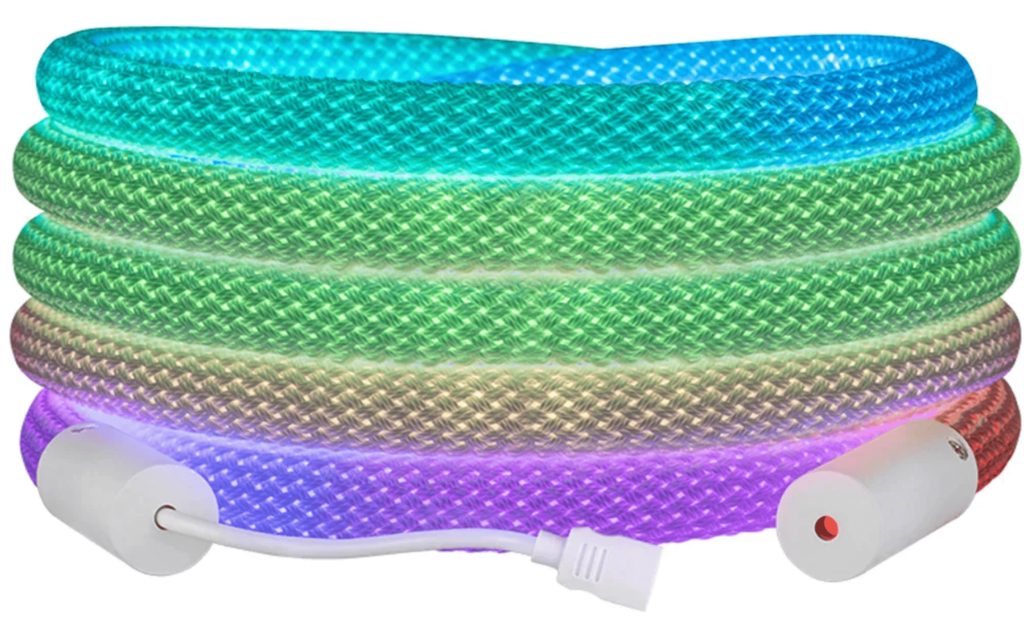
Another popular use is indoor decorative lighting, where they’re draped around mirrors, wound around stair banisters, or strung along mantelpieces for a festive touch during holidays like Christmas. Also, businesses such as restaurants and retail stores commonly use them to enhance their storefronts or interiors by adding a warm, inviting ambiance through carefully designed light displays.
Moreover, rope lights are frequently used in advertising and signage owing to their brightness and visibility. Their ability to be molded into various shapes and letters comes in handy in creating eye-catching displays that attract customer attention.
On a more practical note, rope lights serve as excellent task lighting in workshops or garages where bright, focused light is needed. They are also used as safety lights along corridors or staircases in public buildings or hotels to guide people safely during power outages or low-light situations.
The importance of rope lights lies not just in their luminous capabilities but also in their multifaceted applications, which extend from landscape lighting to safety lighting. These uses underline the vital role they play in our lives – illuminating spaces while also adding an aesthetic appeal.
Understanding the Lifespan of Rope Lights
A Comprehensive Look at Durability and Longevity
Rope lights, often used in landscape lighting to accentuate features or create ambiance, are an integral part of many lighting designs. The lifespan of these rope lights can vary significantly based on several key factors. To fully appreciate and understand these factors, one must delve into them in detail.
Factors Influencing the Lifespan of Rope Lights
The Importance of Quality and Material Selection
The quality and type of material used play a significant role in determining the longevity of rope lights. High-quality materials tend to offer better resistance against wear and tear, thereby extending their service life. For instance, LED rope lights made with robust encapsulation can withstand harsh environments better than their lower-quality counterparts.
Moreover, the type of bulb used within these landscape string lights is crucial. LEDs typically have a longer lifespan than traditional incandescent bulbs due to their lower energy consumption and heat generation. Therefore, opting for LED rope lights could result in an extended lifecycle for your landscape lighting setup.
Frequency and Duration: The Impact on Service Life
In addition to material quality and type, the frequency and duration of usage are vital factors affecting how long rope lights can stay on before they give out. Generally speaking, if you use your rope light continuously 24/7 or turn it on too frequently during a day, it’s likely that it will reach its end of life sooner than expected due to rapid degradation caused by excessive heat generation. However, with prudent use – such as using timing devices to manage when your landscape string lights turn on – you could significantly extend their lifespan by reducing unnecessary operation hours.
Environmental Conditions: The Often Overlooked Factor
Environmental conditions also play a substantial role in determining how long rope lights can stay on. Extreme weather conditions such as intense heat, cold, or moisture can affect the lifespan of both bulb and housing materials. For instance, exposure to UV rays could degrade the plastic material housing the bulbs over time. In addition to this, rope lights installed outdoors as landscape lighting must contend with factors like wind and dust, which can lead to physical damage over time.
Average Lifespan of Different Types of Rope Lights
Incandescent Rope Lights: The Traditional Choice
Incandescent rope lights have been a popular choice for landscape lighting due to their warm light output and affordability. However, they have a shorter lifespan compared to their LED counterparts.
A typical incandescent bulb lasts approximately 1,000 to 2,000 hours before it needs replacing. This essentially means that if you were to use your incandescent landscape string lights for about three hours every day, they would last for a little over a year before you’d need replacement bulbs.
LED Rope Lights: The Long-Lasting Contender
In contrast to incandescent rope lights, LED rope lights boast significantly longer lifespans – typically around 25,000 to 50,000 hours of continuous usage, depending on the model and quality. Given their energy efficiency and durability against environmental factors such as temperature fluctuations and moisture, LED rope lights make an excellent choice for prolonged outdoor use.

If used similarly – around three hours every day – these landscape string lights could last between 22 years (for those with a 25k-hour lifespan) up to an impressive 45 years (for those rated at 50k hours). This long lifespan makes them ideal candidates for permanent landscape lighting installations where longevity is desired.
How Long Can Rope Lights Stay On: The Lighting Chronicles
The longevity of rope lights largely depends on their type, the conditions under which they are used, and the duration of their usage. Consequently, understanding how long rope lights can stay on requires keen attention to these determining factors.
It’s crucial to comprehensively explore what happens when landscape string lights are left on for extended periods and address any safety or efficiency concerns that may arise. Undeniably, rope lighting plays a pivotal role in creating enchanting nocturnal aesthetics in various settings such as homes, gardens, and commercial spaces.
Thus, it’s essential to establish a balance between achieving desired lighting effects and maintaining safety precautions. This exploration will help users make informed decisions about using landscape lighting while simultaneously ensuring the prolonged life of these luminous marvels.
Moreover, discerning not only how long rope lights can stay on but also what repercussions this may have is paramount. This knowledge enables individuals to create an ideal lighting environment without compromising the integrity or lifespan of their rope lights.
A Tale of Two Types: Incandescent vs LED Rope Lights
In terms of durability and hours they can stay lit continuously without causing any potential risks or technical failures, incandescent and LED rope lights significantly differ.
The Incandescent Epoch: Duration in Light Years
Incandescent rope lights are often favored for their distinct warm glow characteristic that recreates an ambiance reminiscent of firelight or candlelight situations. However, compared to their LED counterparts, incandescent bulbs tend to have a shorter lifespan – typically ranging from 1,000 to 2,000 hours with continuous use.
Thus it is generally recommended that incandescent landscape rope lights not be used for more than 12 continuous hours at a time. This limitation is primarily due to their inherent design, which requires a substantial amount of energy to heat the filament that produces light. Consequently, prolonged use can lead to overheating and potential fire risks.
Apart from the safety concerns, excessive usage also accelerates the degradation process of incandescent bulbs. Natural wear and tear resulting from constant heating and cooling of the filament often leads to a steady decrease in light quality over time.
Additionally, incandescent rope lights have relatively higher energy consumption rates. Hence, leaving them on for extended periods not only shortens their lifespan but could also significantly increase your electricity bill.
LED: The Light Brigade
On the other hand, LED rope lights present an entirely different narrative when it comes to duration of use. Thanks to their cool operating temperatures and highly efficient light-emitting diode technology, LED rope lights boast an impressive lifespan – often up to 50,000 hours or more with continuous usage.
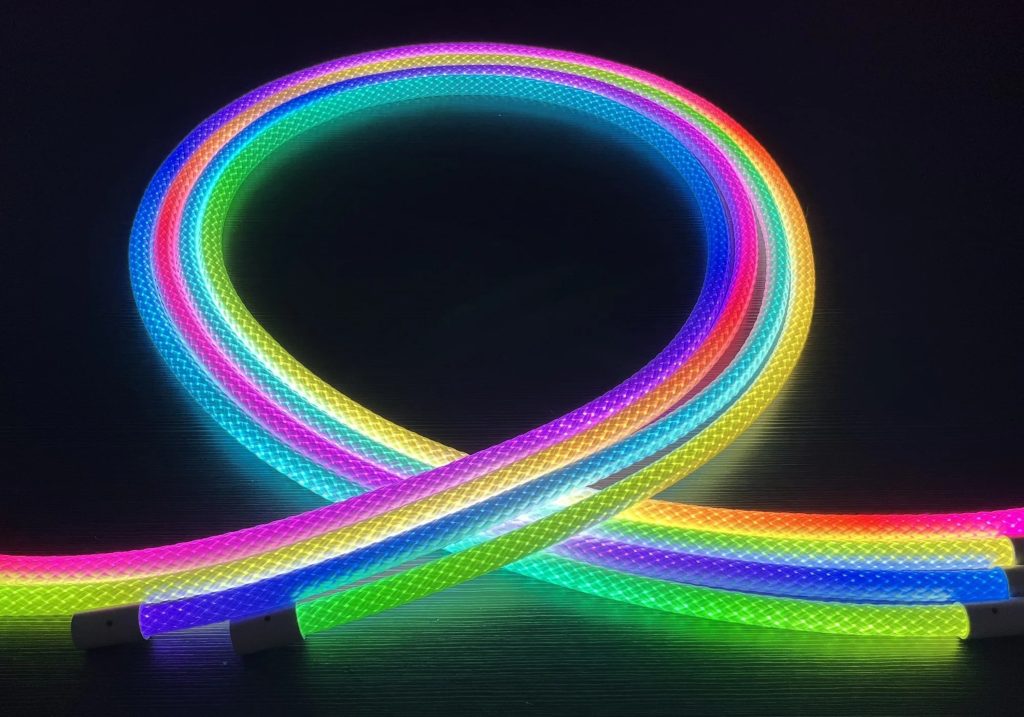
Consequently, LED landscape rope lighting can be left on continuously for much longer periods – up to 24 hours at a time – without raising significant safety or efficiency concerns. The absence of filaments in LED bulbs eliminates any risks associated with overheating and subsequent fire hazards. With LEDs as well, minimal degradation in light quality occurs over time even with continuous use.
This is primarily because LEDs produce light through electroluminescence rather than heat-induced incandescence – a process far less taxing on bulb components. The cherry on top is that LED rope lights consume significantly less energy compared to incandescent bulbs while providing brighter lighting output – making them an economically and environmentally friendly option for long-term landscape lighting needs.
The Potential Risks: Unveiling Pandora’s Box
As highlighted above, prolonged use of rope lights, especially incandescent types, comes with a handful of potential risks. This section delves deeper into these hazards and provides insights into how they can be managed or entirely avoided.
Fire: The Incendiary Intruder
The most alarming risk associated with prolonged use of incandescent rope lights is the potential fire hazard. This threat arises from the excessive heat produced by these bulbs, which can reach dangerously high temperatures in excess of 200 degrees Fahrenheit. If left on for extended periods, especially in close proximity to inflammable materials like fabrics or dry vegetation, they can pose serious fire risks.
In contrast, LED rope lights operate at much cooler temperatures, reducing this risk significantly. However, it’s still crucial to ensure that any type of landscape lighting is strategically placed away from combustible materials as precautionary measures against potential fire hazards.
Fading Lights: The Dimming Dilemma
Another critical concern linked to prolonged usage of rope lights is degradation in light quality over time. In cases where incandescent bulbs are incessantly used beyond their recommended duration, a steady decline in lighting quality is inevitable due to gradual filament erosion.
LEDs also experience light degradation over time but at a significantly slower rate than their incandescent counterparts. This phenomenon – known as lumen depreciation – affects all types of light sources but occurs much slower in LED bulbs due to their inherent energy-efficient design and operation mechanisms.
The Power Play: Energy Consumption Implications
Last but not least, energy consumption implications cannot be overlooked when assessing how long rope lights can stay on without causing detrimental effects. As previously mentioned, the energy efficiency of each type varies considerably, with LEDs being up to 80% more efficient than incandescents.
Therefore, while it might be tempting to leave your incandescent rope lights on for extended periods, doing so can lead to substantial increases in your energy usage and subsequently your electricity costs. Conversely, the high energy efficiency of LED landscape lighting allows for longer hours of operation without significant hikes in energy expenditures.
Special Cases: Can They Stay On Indefinitely?
A Closer Look at Perpetual Lighting Promises
The issue of infinite lighting has spurred much debate among consumers and industry experts alike. Some manufacturers of landscape string lights boldly claim their products can remain lit indefinitely, creating a constant, unbroken stream of light for your landscape lighting needs.
In reality, the concept of unending or perpetual lighting is somewhat misleading. While it may be technically possible for certain types of rope lights to function continuously over an extended period, this does not necessarily mean they should be left on indefinitely.
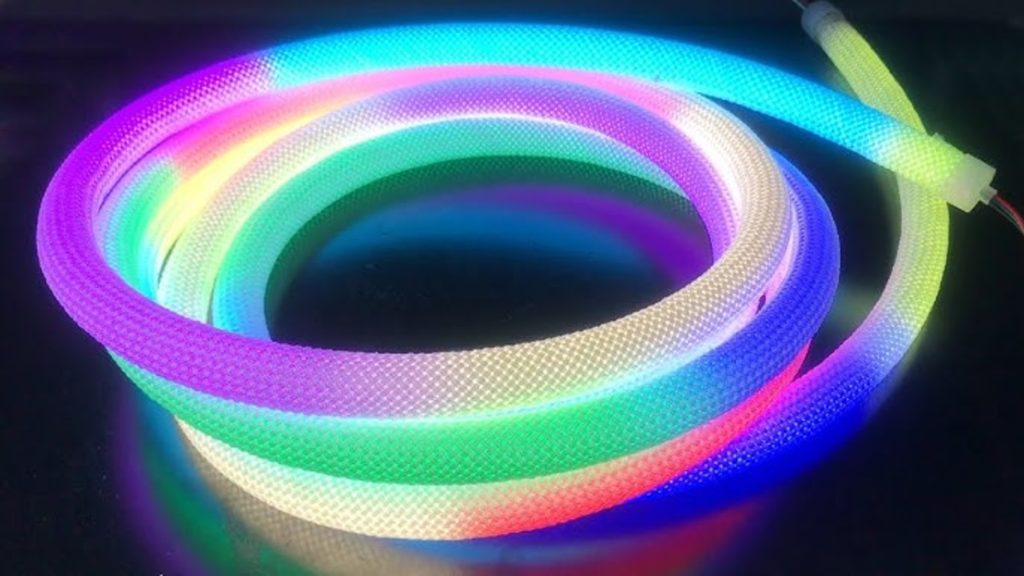
Durable LED rope lights are capable of impressive performance under ideal conditions – some models may maintain uninterrupted operation for up to 50,000 hours or approximately 5.7 years if left on continuously! This makes them suitable for long-term landscape lighting projects that require consistent illumination.
However, these dazzling statistics must be viewed within the context of practical use and product safety. The notion that one can simply switch their rope lights on and forget about them is not only unrealistic but potentially dangerous.
Evaluating Claims versus Reality
Beyond manufacturer claims regarding continuous use are the real-world variables associated with everyday use. These include fluctuations in power supply and environmental factors like temperature changes or adverse weather conditions that could impact the longevity and performance of your landscape string lights. Consider also the element of human error – accidental damage during installation or maintenance can drastically reduce the lifespan of your rope lights irrespective of their theoretical capacity for continuous operation.
While it’s enticing to believe in a one-size-fits-all solution to indefinite landscape lighting, practical considerations necessitate a more nuanced approach. Like any electrical appliance, even the sturdiest rope lights will eventually succumb to wear and tear if they are subjected to relentless use without adequate rest periods.
Validity and Safety Concerns
Assessing the Veracity: Understanding the Fine Print
When evaluating claims surrounding indefinite use, it’s important to take a cautious and informed stance. Manufacturer warranties often have clauses and conditions that could invalidate guarantees if rope lights are used in ways that exceed recommended guidelines, such as continuous operation beyond specified limits.
Furthermore, despite advancements in technology enhancing the durability and longevity of LED rope lights, they are not immune to degradation over time. Gradual wear may lead to a reduction in light quality or brightness over time, even if there is no immediate failure.
Safety First: The Risks of Ignoring Guidelines
Safety should always supersede theoretical boundaries when it comes to using landscape string lights or any other form of electrical equipment. Overutilization can generate excessive heat, which poses a potential fire risk, especially if the rope lights are installed near flammable materials.
Continuous operation also increases the risk of electrical faults developing over time. These faults could manifest subtly at first but later escalate into serious safety hazards such as sparking or short-circuiting.
Ultimately, while perpetual operation might seem like an attainable goal in theory – in reality – it’s prudent to prioritize safety and longevity over relentless illumination. It serves us well to remember that even our most advanced technologies must bow before the inexorable passage of time.
Tips to Extend the Lifespan and Efficiency of Your Rope Light
Ensuring Longevity through Proper Installation Practices
One of the most critical steps in ensuring the durability and efficiency of your rope lights, whether they are used as landscape lighting or interior decoration, is proper installation. The importance of this step cannot be overemphasized.
Firstly, make sure you have chosen a suitable type of rope light for your particular usage scenario. For instance, if you’re contemplating installing landscape string lights in outdoor spaces, opt for waterproof and weather-resistant variants. Not doing so could jeopardize the longevity of your lights.
Secondly, avoid unnecessary bending or folding during installation, as this could potentially damage the internal wiring and decrease the life span of your rope light. Always follow manufacturer guidelines about how much bending is too much.
Thirdly, refrain from connecting too many strings together; overloading can cause overheating, which could both shorten their lifespan and pose safety risks. It’s advisable to use mounting clips for secure attachment. This will keep your lights stable in their position, thus reducing chances of potential damage caused by wind or accidental hits.
Maintenance Tips: Prolonging Your Rope Light’s Glow
Proper maintenance is significant to get maximum output from your rope light while extending its lifespan concurrently. Cleanliness is essential when maintaining any lighting system, including rope lights used for landscape lighting. Dust can accumulate on the surface over time, causing them to lose their brightness. Regular dusting will ensure they retain their glow longer.
Prompt replacement of burnt-out sections is another crucial maintenance task that shouldn’t be overlooked: leaving such sections unattended can affect other functioning parts, leading to a total failure earlier than expected. When replacing a section or bulb in incandescent light ropes – something you won’t deal with in LED versions – always turn off the power supply first to ensure safety and avoid possible surge damage.
During severe weather conditions, consider taking down your landscape string lights temporarily if they are not rated for such conditions. This preventative measure can go a long way in prolonging their life.
Smart Usage Habits: Optimizing Efficiency and Lifespan
Adopting smart usage habits is key to optimizing both the efficiency and lifespan of your rope lights. Firstly, even though rope lights are designed for prolonged use, it’s advisable to turn them off when not needed. Leaving them on perpetually will not only consume more energy but also shorten their lifespan due to constant wear and tear.
Secondly, incorporating timers or sensors could be beneficial. Timers will ensure that the rope lights are only on when necessary, while motion sensors can help save energy by lighting up only when movement is detected. This helps especially in scenarios where you may forget to switch off your lights or if you want your landscape string lights functioning at specific times.
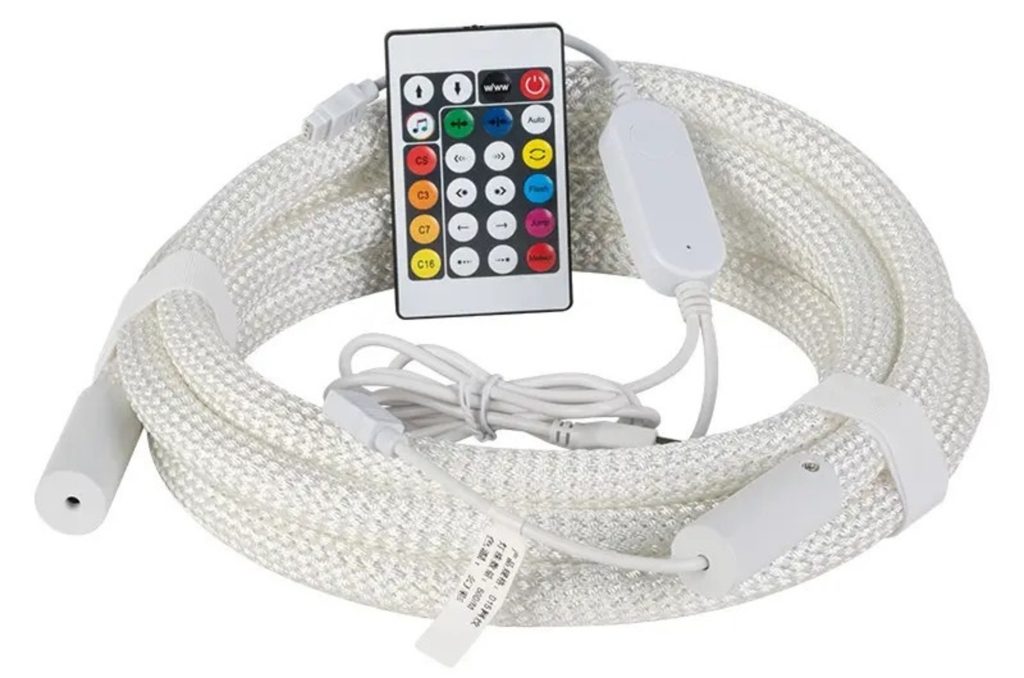
Thirdly, avoid exposing your rope light to undesirably high or low temperatures if possible, as extreme temperature fluctuations can impact the durability of the material used in making the light ropes. Regular inspection of your rope light setup for any potential issues, such as fraying or exposed wires, is recommended.
Early detection and rectification of these issues ensures safety while maintaining efficient function and preventing premature failure. With proper installation practices, regular maintenance efforts, and smart usage habits incorporated into routine user behavior, you’re sure to extend both the lifespan and efficiency of your landscape lighting solution using string or rope lights.
Balancing Longevity, Safety, and Efficiency in Using Your Rope Light
A Harmonized Approach to Rope Light Usage
Understanding and effectively managing the intricate interplay between longevity, safety, and efficiency in rope light usage is crucial. If you’re using rope lights as landscape string lights to give your garden a warm glow at night, these factors must be considered.
Longevity is primarily influenced by the build quality of your rope lights and how frequently you use them. Opting for high-quality LED rope lights over their incandescent counterparts would invariably provide a longer lifespan with more efficient power consumption. Moreover, these LED variants are safer with less chance of overheating.
Nevertheless, even the most robust LED rope light has its limitations on how long it can stay on continuously. Beyond a certain duration lies potential risks such as degradation in light quality and fire hazards due to overheating.
Prioritizing Safety in Rope Lighting
Safety should never be compromised or undermined when dealing with any form of lighting, including rope lighting. It’s easy to get swept up in the allure of having your landscape string lights twinkle from dusk till dawn, but one must remember that prolonged use without intermittent breaks might spell trouble.
Fire hazards emerge when the heat from continuous usage begins to degrade the plastic housing of rope lights, causing it to melt or even ignite, especially for lower-quality or worn-out models. On this score, it’s important to note that while some manufacturers may claim their product can safely run continuously without a hitch, users are advised to exercise caution and common sense above all else.
Maintaining an Efficient Landscape Lighting System
Efficiency is another aspect worthy of attention when using your rope lights, either for landscape lighting or other uses. Prolonged use leads not only to potential risks but also to higher energy consumption. LED rope lights, though more efficient than incandescent versions, still consume energy. Leaving them on indefinitely constitutes unnecessary energy wastage and invariably translates to higher electricity bills.
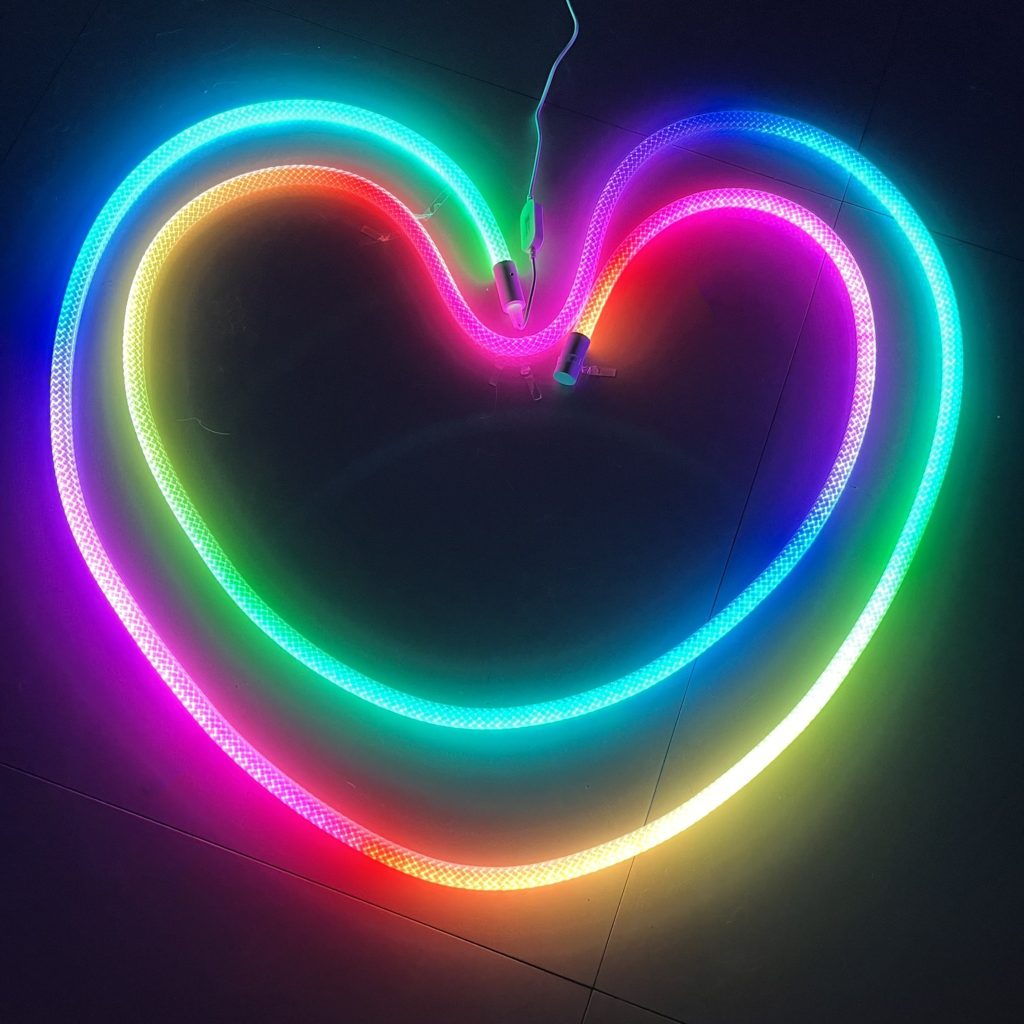
Therefore, a balanced approach would be to utilize timers or sensors that automatically switch off your landscape string lights after a certain period or when natural light is sufficient. This way, you can enjoy the aesthetic appeal of your gleaming garden at night without incurring exorbitant electricity costs or compromising on safety.
Striking the Ideal Balance
In striking a balance between longevity, safety, and efficiency in using rope lights for landscape lighting, one needs to consider quality products with proven longevity, adopt cautious usage habits respecting recommended durations of continuous use, and incorporate smart practices like automated timers or sensors to optimize efficiency. Above all else, remember that lighting serves not just an aesthetic purpose but should also bolster safety. Hence, ensure your landscape string lights don’t transform from enchanting garden illuminators into potential fire hazards due to negligent usage practices.
Conclusion: A Holistic Approach to Understanding Rope Lights
Knowledge about the subject matter is gleaned from various sources: academic research articles, industry reports detailing product specifications and maintenance protocols, comprehensive books outlining best practices for installation and usage, and online platforms brimming with practical experiences shared by end-users.
No matter what source one refers to, all agree that maintaining a balance between the longevity, safety, and efficiency of rope lights is key. Whether you’re considering installing landscape string lights or other types of landscape lighting in your backyard or seeking ways to ensure your LED Christmas rope light lasts another holiday season – understanding the estimated lifespan of your product proves invaluable.
References: Reliable Sources on the Subject Matter
Peer-Reviewed Journals: A Wealth of Knowledge on Lighting
An exhaustive number of articles have been written on rope lights, their longevity, and suitable usage. Peer-reviewed journals such as ‘The Journal of Light & Visual Environment’ and ‘Optics Express’ contain a wealth of knowledge about both the technological advancements in lighting systems and also their practical applications, such as landscape string lights.
In an interesting study on LED technology, ‘Lifetime estimation of white LED using Degradation Data Analysis’, published in the Journal of Light & Visual Environment, researchers explore the factors contributing to LED lifespan (Ishii et al., 2016). This piece proves invaluable to anyone seeking a deeper understanding about how long rope lights can stay on, especially those made from LEDs.
Industry Reports: Unveiling Commercial Insights
Industry reports are another excellent source for information concerning rope lights’ longevity. Renowned entities like Philips Lighting and GE Lighting frequently release reports detailing product specifications, including estimated lifespans for their lighting products.
The Philips’ report titled ‘Long Lifetime LED Lamps’ provides extensive insights into understanding how long LED rope lights can stay on (Philips Lighting B.V., 2018). Such reports provide commercial insights that make it feasible to predict rope light longevity with high precision.
Moreover, these reports often discuss best practices for installing and maintaining landscape string lights, enhancing not only aesthetic appeal but also safety measures. These recommendations are particularly relevant when discussing continuous usage implications.
Books: Comprehensive Guides into Landscape Lighting
Books offer a more comprehensive guide into landscape lighting, including different types like rope and string lights. For instance, Janet Lennox Moyer’s book, ‘The Landscape Lighting Book’, covers design techniques and installation methods while also shedding light on maintenance practices that could potentially extend the lifespan of such lights (Moyer, 2013).
Online Forums and Blogs: Practical Experiences and User Reviews
While academic journals, industry reports, and books provide detailed insights on a theoretical level, online forums and blogs are teeming with real-life experiences. Websites such as Lightology’s blog offer guides for choosing landscape lighting, while platforms like Reddit have discussions about how long users can keep their rope lights on.
You may also be interested in the following posts:
